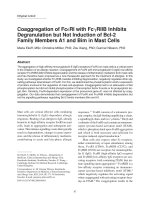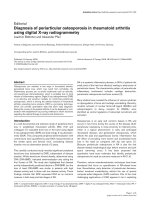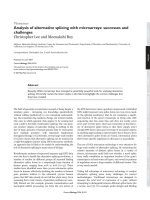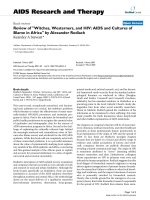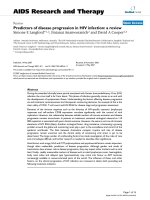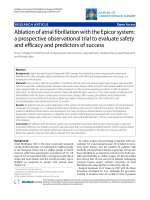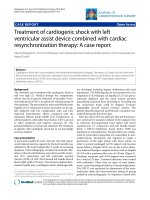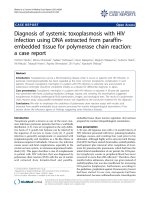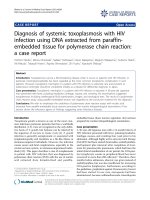Báo cáo y học: "Diagnosis of systemic toxoplasmosis with HIV infection using DNA extracted from paraffinembedded tissue for polymerase chain reaction: a case report" ppt
Bạn đang xem bản rút gọn của tài liệu. Xem và tải ngay bản đầy đủ của tài liệu tại đây (465.02 KB, 5 trang )
CAS E REP O R T Open Access
Diagnosis of systemic toxoplasmosis with HIV
infection using DNA extracted from paraffin-
embedded tissue for polymerase chain reaction:
a case report
Yoichiro Okubo
1
, Minoru Shinozaki
1
, Sadako Yoshizawa
2
, Haruo Nakayama
1
, Megumi Wakayama
1
, Tsutomu Hatori
1
,
Aki Mituda
1
, Takayuki Hirano
1
, Kayoko Shimodaira
1
, Zhi Yuzhu
1
, Kazutoshi Shibuya
1*
Abstract
Introduction: Toxoplasmosis can be a life-threatening disease when it occurs in patients with HIV in fection. In
particular, meningioencephalitis has been regarded as the most common toxoplasmic complication in such
patients. However, toxoplasmic meningitis in a patient with HIV infection is extremely rare and purulent or
tuberculous meningitis should be considered initially as a disease for differential diagnosis in Japan.
Case presentation: Toxoplasmic meningitis in a patient with HIV infection is reported. A 36-year-old Japanese
man presented with fever, pulsating headache, lumbago, nausea, and vomiting. No examinations suggested
toxoplasmosis including cerebrospinal fluid examinations, images, and serological tests. The result of a polymerase
chain reaction assay using paraffin-embedded section was regarded as the conclusive evidence for the diagnosis.
Conclusions: We wish to emphasize the usefulness of polymerase chain reaction assays with nucleic acid
extracted from paraffin-embedded tissue sections processed for routine histopathological examination, if the
section shows the infectious agents or findings suggesting some infectious diseases.
Introduction
Toxoplasma gondii is known as one of the most com-
mon infectious protozoan parasites that has a worldwide
distribution [1-3]. Cats are recognized as the only defini-
tive hosts of T. gondii, but humans can be infected by
the ingestion of oocysts or tissue cysts [4]. T. gondii
infection is generally asymptomatic or associated with
lymphadenopathy and manifests as a flu-like illness in
immunocompetent individuals. However, the infection
causes severe and fatal complications, especially in the
central nerv ous system, in immunocompromised indivi -
duals [2,5]. This paper describes a case of toxoplasmosis
in patient with HIV infection that was diagnosed b y
polymerase chain reaction (PCR) with the use of nucleic
acid extracted from formalin-fixed and paraffin-
embedded tissue (bone marrow aspiration clot) sections
prepared for routine histopathological examination.
Case presentation
A 36-year-old Japanese man with a 14-month history of
HIV infection presented with fever, pulsating headache,
lumbago, nausea, and vomiting four week prior to his
admission. Al though hig hly active anti-retroviral therap y
(HAART) had been star ted (lamivudine, azidothymidine,
and lopinavir plus ritonavir) after completion of treat-
ment for pneumocystis pneumonia, which had been the
initial clinical manifestation of our patient, his CD4-posi-
tive lymphocyte counts in peripheral blood has never
recovered to more than 200 cells/mm
3
. Therefore, three
months before admission, abacavir was given instead of
azidothymidine, but was also insufficient for increasing
CD4-positi ve lymp hocytes. Furthermo re, a ccording to
the guidelines, pr ophylaxi s against Pneumocystis jirovecii
had been started. In our case, atovaquone had been
administered, because sulfamethoxazole-trimethoprim
* Correspondence:
1
Department of Surgical Pathology, Toho University School of Medicine,
6-11-1 Omori-Nishi, Ota-Ku, Tokyo, 143-8541, Japan
Full list of author information is available at the end of the article
Okubo et al. Journal of Medical Case Reports 2010, 4:265
/>JOURNAL OF MEDICAL
CASE REPORTS
© 2010 Okubo et al; licensee BioMed Central L td. This is an Open Access article dist ributed under the terms of the Creative Co mmons
Attribution License ( which permits unrestricted use, distribution, and reproduction in
any medium, provided the original work is properly cited.
and pentamidine had caused hepatic and renal insuffi-
ciency, respectively. On physical examination, our patient
reported headache with neck stiffness. His axillary tem-
perature was 38.2°C. Chest radiography and computed
tomography (CT) of the brain showed no abnormalities.
He was diagnosed as purulent meningitis, initially,
because of an increasin g of neutrophils count in cere-
brospinal fluid (CSF). Broad-spectrum antimicrobials,
however, had no effect on this meningitis. CD4-positive
lymphocyte counts 146/μlinperipheralblood.Hedid
not show inc reasing of immunoglobulin G (IgG) and
immunoglobulin M (IgM) fraction of anti -T. gondii anti-
body (enzyme-linked immunosorbant assay, ELISA).
Three weeks after admission, due to worsened headache
and lumbago, magnetic re sonance imagin g (MRI) of the
brain and lumbar vertebrae was performed and showed
enhanced small nodules at right superior pons and bilat-
eral superior cerebellum, peripheral enhancement at the
bilateral superior pons, and enha nced lesions which was
parallel to left inner ear. These findings strongly sug-
gested meningitis with granuloma formation, such as
tuberculosis. Furthermore, MRI of the lumber vertebrae
also suggested the presence of the gr anulomatous lesion.
However, the PCR assay targeting mycobacterium tuber-
culosis was negative. Therefore, bone marrow aspiration
biopsy was performed for histopathological examination
to elucidate the causative agent of generalized infection.
The specimen, bone marrow aspiration clot, was fixed
with 10% formalin and embedded in paraffin wax after
dehydration which was cut into 3 μm-thick sec tions, and
routinely stained wi th hematoxylin and eosin double
stain. Histopathological examination indicated hypocellu-
lar bone marrow in which clustered intra-cellular baso-
philic granuli were present ( Figure 1). These were
confirmed as microcalcification by Von Kossa’sstain.
Therefore, the PCR assay with toxoplasma-specific pri-
mer was performed usin g nucleic acid extracted from the
formalin-fixed and paraffin-embedded tissue (bone mar-
row aspir ation) section. In the p rocedure, paraffin-
embedded tissue sections (bone marrow aspiration clot)
were deparaffinized by xyleneandimmersedinabsolute
ethanol . The air-dried pellets of d ehydrated section were
then resuspended in extraction buffer (Tris-HCl [50 mM,
pH 8.5], NaCl [50 mM], EDTA [10 mM], sodium dodecyl
sulfate [0.5%], proteinase K [10 mg/mL]) at 95°C. The
samples were completely submerged in the extraction
buffer and incubated at 56°C for 12 hours. The superna-
tant was then purified by phenol-chloroform extraction
and ethanol precipitation, and was resuspended in 25 mL
of DNase-free buffer (Tris-HCl [10 mM], EDTA [1
mM]), and was stored at 20°C until use for DNA amplifi-
cation. PCR for B1 gene of T. gondii was carried out fol-
lowing the previous description of Tachikawa et al. [6].
The primers used in the assay are summarized in
Additional file 1. Conditions of nested PCR for T. gondii
were 0.5 pmol/L primer, 2.5 mM MgCl
2
, 0.2 mM dNTP,
and 0.02 U/L Taq DNA po lymerase. First PCR was per-
formed in thermal cycler sta rting with a pre-incuba tion
at 94°C for three minutes, followed by 40 PCR cycles of
oneminutedenaturationat94°C,oneminuteannealing
at 58°C, one minute elongation at 72°C. The first PCR
product was added to a new reaction mixture. Composi-
tions and PCR cycles were same as the first PCR. Sec ond
PCR product was electrophoresed on a 3% agarose gel.
As a result, the specific PCR product of T. gondii was
obtained from the extract from paraffin-embedde d tissue
sectionsofthebonemarrowbiopsy(Figure2).Anti-
T. gondii therapy consisting of pyrimethamine, clindamy-
cin, and leucovorin had been started. After sulfadiazine
desensitization, clindamycin was replaced with sulfadia-
zine. Together with this, although our patient was nega-
tive on fr equent PCR assay for tuberculo sis, anti-
tubercular treatment had been continued due to sus-
pected tuberculosis from MRI. According to this, his
fever was improved, but other clinical symptoms
remained. Finally, anti-T. gondii therapy consisting pyri-
methamine, sulfadiazine, and leucovorin plus predniso-
lone had an effect on improving his clinical symptoms
and he was referred to other hospital in his home city at
his request.
Figure 1 Hematoxylin and eosin stain of bone marrow.
Hematoxylin and eosin stain of bone marrow. Clustered intra-
cellular basophilic granuli suggesting toxoplasmosis was present
(x1000).
Okubo et al. Journal of Medical Case Reports 2010, 4:265
/>Page 2 of 5
Discussion
Toxoplasmosis can be a life-threatening disease when it
occurs in patients with HIV infection with decreased
CD4 positive lymphocytes [7]. In particular, encephalitis
is the most common toxoplasmic complication in such
individuals [8]. It has been reported that the incidence of
toxoplasmic meningioencephalitis ranges from 3 to 50%
[9]. However, in Japan, the latest study reported that only
1.07% of patients with HIV develop toxoplasmo sis [10]
and the seroprevalence of IgG anti-toxoplasma antibodies
in Japanese patients was less than 10% [11,12]. Therefore,
as toxoplasmic meningi tis in patients with HIV infection
is extremely rare, purulent or tuberculous meningitis
should be considered initially as a disease for differential
diagnosis. In our case, neither CSF examinations nor
MRI of the brain were typi cal for toxoplasmosis. Failure
of our patient’s symptoms to respond to anti-bacterial
and anti-tubercular treatment led us to perform bone
Figure 2 Result of nested PCR for T. gondii. The detection threshold of nested PCR for T. gondii. 194 bp was the expected size of nested PCR
for T. gondii (Abbreviation, MW: molecular weight).
Okubo et al. Journal of Medical Case Reports 2010, 4:265
/>Page 3 of 5
marrow biopsy to search for another cause of generalized
opportunistic infection. Histopathological findings from
bone marrow biopsy suggested toxoplasmosis because
the evidence of c lustered micro-calcifyin g granules, but
this finding was not adequate to diagnose the disease
definitively. Therefore, to make the diagnosis, we
employed a PCR assay using nucleic acid extracted from
formalin-fixed and paraffin-embedded tissue section of
the bone marrow. A major and classical diagnostic proce-
dure for toxoplasmosis has been constituent with both
serological tests and histopathological examinations [1],
but these methods have limitations. In particularly, sero-
logical tests often fail to detect T. gondii infecti on in
patients with HIV infection due to their decreased func-
tioning of immunoglobulin production [13]. Recently,
several PCR assays have been developed with different
gene targets. Among them, a detection of T. gondii DNA
has been regarded as one of the useful diagnostic proce-
dures [1]. Furthermore, the potential of PCR assay to
detect T. gondii in CSF has been previously reported, in
which the sensitivity a nd specificity were described
between 44 and 100%, 94 and 100%, respectively [9]. PCR
assay using CSF could be successful to detect ge ne form
T. gondii. However, to avoid an invasive diagnostic proce-
dure we employed a PCR assay using nucleic acid
extracted from the paraffin-embedded sections, which
also had revealed strongly sugge stive alterations for the
toxoplasmosis. Although there was only a report that
referred to PCR assay using nucleic acid e xtracted from
paraffin-embedded tissue sections and this method has
not been validated until now [14].
Conclusions
We wish to emphasize the usefulness of PCR assay
using nucleic acid extracted from paraffin-embedded tis-
sue sections processed f or routine histopathological
examination, if the section shows the infectious agents
or findings suggesting some infectious diseases.
Additional material
Additional file 1: Primers of nested PCR for T. gondii.
Abbreviations
CSF: cerebrospinal fluid; CT: computed tomography; HAART: highly active
anti-retroviral therapy; HIV: human immunodeficiency virus; IgG:
immunoglobulin G; MRI: magnetic resonance imaging; PCR: polymerase
chain reaction.
Consent
Written informed consent was obtained from the patient for publication of
this case report and any accompanying images. A copy of the written
consent is available for review by the Editor-in-Chief of this journal.
Competing interests
KS reports received research grants from Pfizer Japan Inc., Janssen
Pharmaceutical K.K., and Dainippon Sumitomo Pharma Co. All authors
declare that they have no competing interests.
Authors’ contributions
YO, conceptualized the case report, integrated the data, and wrote the
manuscript as a major contributor; MS, carried out the HE stain, Von Kossa’s
stain, immunohistochemical staining and PCR assay; SY, contributed to
management of the patient; HN, MW, TH, AM, and TH, carried out the
histopathologic evaluation and revised histopathological description; KS, and
ZY, assisted PCR assay; KS, gave final approval to the manuscript as a
corresponding author. All authors contributed to conceptualizing and
writing this case report.
Acknowledgements
This work was supported by the Health Science Research Grants for
Research on Emerging and Re-emerging Infectious Diseases (H16-Shinko-6
and H19-Shinko-8), Measures for Intractable Diseases (H20 nannchi ippann
35) from Ministry of Health, Labour and Welfare of Japan, and by Grant of
the Strategic Basis on Research Grounds for Non-governmental Schools at
Heisei 20th from Ministry of Education, Culture, Sports, Science and
Technology-Japan to K.S and Toho University project grant #21-24 to Y.O.
Author details
1
Department of Surgical Pathology, Toho University School of Medicine,
6-11-1 Omori-Nishi, Ota-Ku, Tokyo, 143-8541, Japan.
2
Department of Infection
Control, Toho University Medical Center, Omori Hospital, 6-11-1 Omori-Nishi,
Ota-Ku, Tokyo, 143-8541, Japan.
Received: 16 November 2009 Accepted: 11 August 2010
Published: 11 August 2010
References
1. Dubey JP: The history of Toxoplasma gondii–the first 100 years. J Eukaryot
Microbio 2008, 55:467-475.
2. Boothroyd JC, Grigg ME: Population biology of Toxoplasma gondii and its
relevance to human infection: do different strains cause different
disease? Curr Opin Microbiol 2002, 5:438-442.
3. Petersen E: Toxoplasmosis. Semin Fetal Neonatal Med 2007, 12:214-223.
4. Kasper L, Courret N, Darche S, et al: Toxoplasma gondii and mucosal
immunity. Int J Parasitol 2004, 34:401-409.
5. Correa D, Cañedo-Solares I, Ortiz-Alegría LB, Caballero-Ortega H, Rico-
Torres CP: Congenital and acquired toxoplasmosis: diversity and role of
antibodies in different compartments of the host. Parasite Immunol 2007,
29:651-660.
6. Tachikawa N, Goto M, Hoshino Y, et al: Detection of Toxoplasma gondii,
Epstein-Barr virus, and JC virus DNAs in the cerebrospinal fluid in
acquired immunodeficiency syndrome patients with focal central
nervous system complications. Intern Med 1999, 38:556-562.
7. Nissapatorn V, Lee C, Quek KF, Leong CL, Mahmud R, Abdullah KA:
Toxoplasmosis in HIV/AIDS patients: a current situation. Jpn J Infect Dis
2004, 57:160-165.
8. Barbosa CJ, Molina RJ, de Souza MB, et al: Disseminated toxoplasmosis
presenting as sepsis in two AIDS patients. Rev Inst Med Trop Sao Paulo
2007, 49:113-116.
9. Goto M, Takahashi T, Kanda T, Iwamoto A: Detection of Toxoplasma gondii
by polymerase chain reaction in cerebrospinal fluid from human
immunodeficiency virus-1-infected Japanese patients with focal
neurological signs. J Int Med Res 2004, 32:665-670.
10. Kano S, Genka I, Yoshida K: Parasitic disease complicated with HIV/AIDS
patients in Japan. Clinical Parasitology 2004, 15:95-98, (in Japanese).
11. Naito T, Inui A, Kudo N, et al: Seroprevalence of IgG anti-toxoplasma
antibodies in asymptomatic patients infected with human
immunodeficiency virus in Japan. Intern Med 2007, 46:1149-1150.
12. Yamaoka M, Konishi E: Prevalence of antibody to Toxoplasma gondii
among inhabitants under different geographical and climatic conditions
in Hyogo Prefecture, Japan. Jpn J Med Sci Biol
1993, 46:121-129.
Okubo et al. Journal of Medical Case Reports 2010, 4:265
/>Page 4 of 5
13. Porter SB, Sande MA: Toxoplasmosis of the central nervous system in the
acquired immunodeficiency syndrome. N Engl J Med 1992, 327:1643-1648.
14. Tsai MM, O’Leary TJ: Identification of Toxoplasma gondii in formalin-fixed,
paraffin-embedded tissue by polymerase chain reaction. Mod Pathol
1993, 6:185-188.
doi:10.1186/1752-1947-4-265
Cite this article as: Okubo et al.: Diagnosis of systemic toxoplasmosis
with HIV infection using DNA extracted from paraffin-embedded tissue
for polymerase chain reaction: a case report. Journal of Medical Case
Reports 2010 4:265.
Submit your next manuscript to BioMed Central
and take full advantage of:
• Convenient online submission
• Thorough peer review
• No space constraints or color figure charges
• Immediate publication on acceptance
• Inclusion in PubMed, CAS, Scopus and Google Scholar
• Research which is freely available for redistribution
Submit your manuscript at
www.biomedcentral.com/submit
Okubo et al. Journal of Medical Case Reports 2010, 4:265
/>Page 5 of 5
